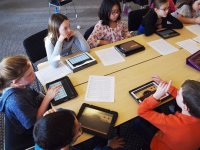Digital Tools to Connect Local Schools
A technology integration specialist offers a selection of web tools to help students share and collaborate with other classrooms in their building or district.
Your content has been saved!
Go to My Saved Content.While the schools in our district are not far apart in terms of distance, it is often difficult for them to make connections with each other even though we have the best intentions and we all realize the potential for increased engagement when we do facilitate these experiences. As part of an increased emphasis on technology integration in our district, as well as our mixed device program, we've started using some tools that we have in common to facilitate these connections between classrooms throughout the district.
Connecting with Twitter, VoiceThread, Popplet and QR Codes makes sense for most of our students, as these tools mimic how many of them already connect digitally on their own. In our district, we've found these four tools successful in engaging students, because they can be used in a variety of ways to organize, create and present information. Our aim is for students to become passionate thinkers and creators, and one path toward realizing this potential is using these digital tools that allow them to explore, collaborate and share their work.
Using Popplet in the Classroom
Popplet allows students to visually organize ideas using text, video and images, and the program can be accessed via the web or through an iPad app. It is easy to use, has intuitive design features (for example, students can change the color of all adjectives in a Popplet) and enables collaboration, as students can add comments to their classmates' Popplets. The commenting feature is great within classrooms, but it also allows other classes -- in the building or from another school -- to add their comments as well. One of our fourth grade classes did character analysis Popplets about a book of their choice, and now another fourth grade class can add their comments to the Popplets and discover new books from their peers. Popplet is also great for collaboration during the organization process for students studying the same topic.
Online Discussion With VoiceThread
VoiceThread is a wonderful tool for building interactive, collaborative presentations. The program allows users to create slides from previously created media, like a PowerPoint or an image, and then add comments by voice, text or visually annotating slides. The program is designed to help students collaborate, comment or ask questions about a classmate's presentation. They no longer have to be in the same building to collaborate on a presentation or learn from their peers. By removing the limitations of the physical classroom, students can find others outside of their own class who share an interest in similar topics and/or an approach to learning and demonstrating understanding.
Intra-School Collaboration on Twitter
Many of our elementary classes now have a class Twitter account, which they use to post reflections on their daily learning, engage in conversations and pose questions to a larger community. Twitter has also given our schools a quick and easy way to connect with students in other buildings. When one of our fourth grade classes finished their character analysis Popplets, they tweeted another fourth grade class and asked them to take a look and share their comments. These seamless connections take away the barriers of the "assignment" and turn classwork into a conversation among students about topics of interest. In turn, they are excited to see what their peers have read and what they think.
21st Century Bookmarks with QR Codes
One way we have been using QR codes -- which are scannable codes that link to media -- is by having students create bookmarks. They can read a book and gather sources like pictures, video clips, websites, articles and any other form of media, and then produce QR code bookmarks. The bookmarks can be left with the book for the next student to read and discover. We've seen how these bookmarks help start conversations between students who've chosen to read the same book.
Challenges in Forging Digital Connections
One of the challenges of using digital tools to connect the schools in our district is the time it takes to familiarize our teachers and students with a new tool. For each new application, teachers need to spend time playing with and learning about the latest ed-tech application. Then they need to spend time teaching their students how to use this tool responsibly.
Finding tools that are safe to use with elementary students and free or reasonably priced is often a challenge as well. We want to find the best tool for our purpose without having to learn a new one each week and without limiting ourselves.
The biggest challenge we face, though, which applies to more than just trying to use digital tools to make connections, is the management of subscriptions and accounts. We want to be sure that we're getting our money's worth if we are paying a subscription fee, and we also don't want students to have a multitude of classroom accounts for tools that should be easy to use. We strive to find those tools that really make the difference in allowing students to collaborate efficiently and effectively -- and that are cost effective for us.
